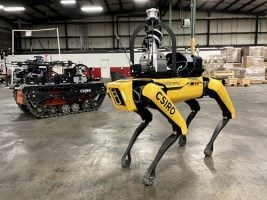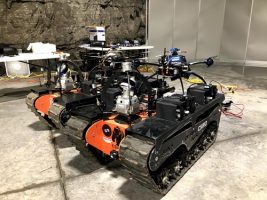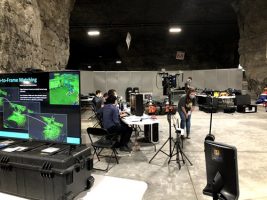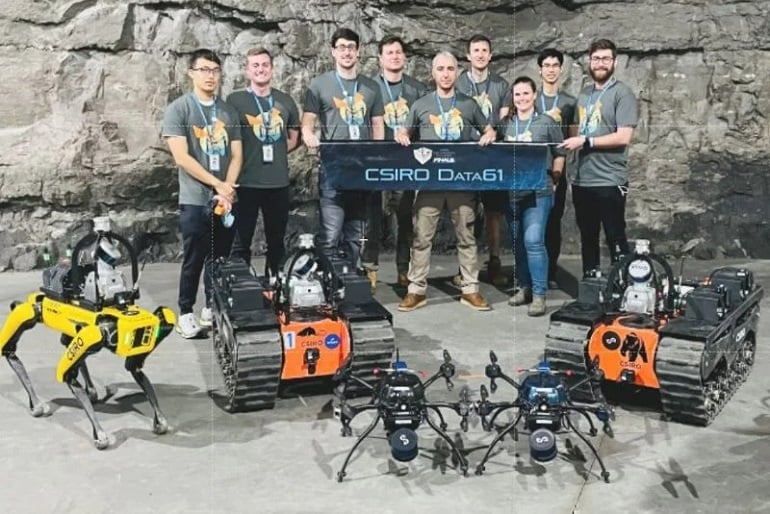Robotics experts from the CSIRO have second finished in a global competition dubbed the ‘Robot Olympics’, beating a team from NASA and MIT to take the silver.
The team, from the CSIRO’s Data61, spin-out robotics company Emesent, and the US-based Georgia Institute of Technology spent three years preparing for the competition, preparing six autonomous robots, nicknaming them after characters in the children’s TV series Bluey.

Bluey, with Bear in the background. Photo: CSIRO
Bluey and Bingo are the dog-like Boston Dynamics Spot bots with the ability to go where other robots can’t.
Bear and Rat, designed by Brisbane-based company BIA5, are tracked all-terrain robots, and can transport other crucial robots with a shorter battery life to emergency situtations. Onboard monitors and multiple cameras allow them to act as the eyes of first responders in dangerous situations and they use Data61 sensor tech to create maps of their often unknown surrounds.
H1 and H2, designed and developed by Emesent, are autonomous drones that can create 3D maps, and record gas readings, videos and images. They don’t need GPS to operate, and can operate up to 600 metres below the surface, with inbuilt collision detection and avoidance tech.
The Subterranean Challenge took place in the US on three underground courses built inside the Louisville Mega Cavern. The competition, organised by US government research agency DARPA (Defense Advanced Research Projects Agency) set challenges are designed to simulate real-world scenarios, such as locating models representing lost or injured humans, backpacks, or phones, as well as variable conditions such as pockets of gas.

Bear and Rat carried H1 and H2 to the search locations
Points are awarded for robots making correct identification and location of items, mapping the terrain, and maintaining autonomy and communications throughout.
The CSIRO’s Data61 team won the preliminary round before being awarded second in the final circuit, outflanking teams from NASA JPL/MIT, California Institute of Technology, and Carnegie Mellon University. Teams from 11 countries competed.
The event was won by CERBERUS in a collaboration between University of Nevada, Reno, ETH Zurich, Sierra Nevada Corporation, University of California, Berkeley, Flyability, the Norwegian University of Science and Technology, and the University of Oxford. They won the US$2 million top prize.
The CSIRO team won US$1 million (A$1.3m) in prize money, which they plan to spend on R&D at Data61.
CSIRO Robotics group leader, Dr Navinda Kottege said it was an amazing result.
“We are the first Australian team to place in the top two at a DARPA robotics challenge. This cements CSIRO’s place as a world leader in robotics and puts Australia firmly on the map in this increasingly important area of science,
“The team will now focus on translating the technology and capabilities developed from this project to solve some of Australia’s greatest challenges.”

The US-based team members in touch with the Australian-based team
Emesent CTO and co-founder Dr Farid Kendoul said finish on the podium was great news for Australia.
“I am so proud of team CSIRO’s Data61 placing second, and the contributions that Emesent made over the three years to advance the team’s state-of-the-art robotics and showcase the capabilities of Australian companies on a global stage,'” he said.
Check out some of the competition below – and 2 hours 5 mins in, when the CSIRO team launch their aerial drone in a crowded storage room, only to have it taken out by a sheet of paper whipped up by the winds generated by the rotors.




















Trending
Daily startup news and insights, delivered to your inbox.